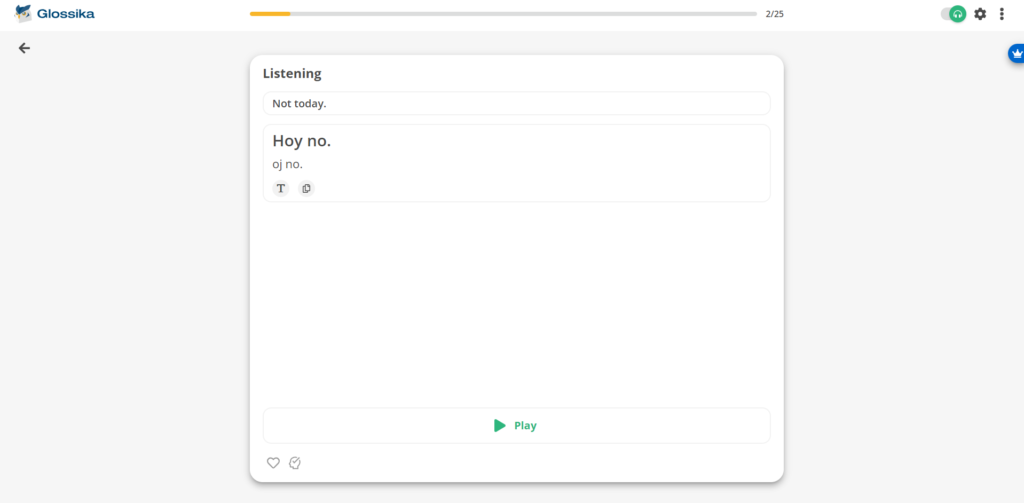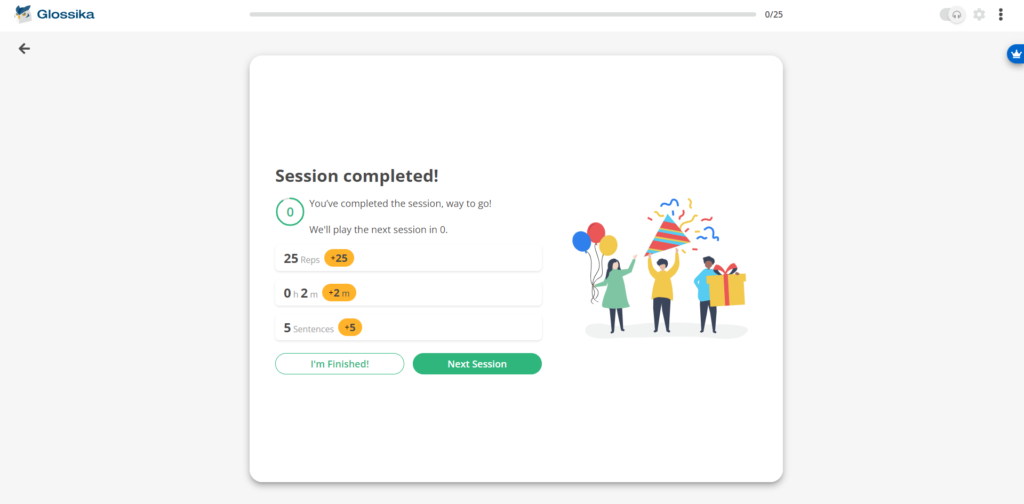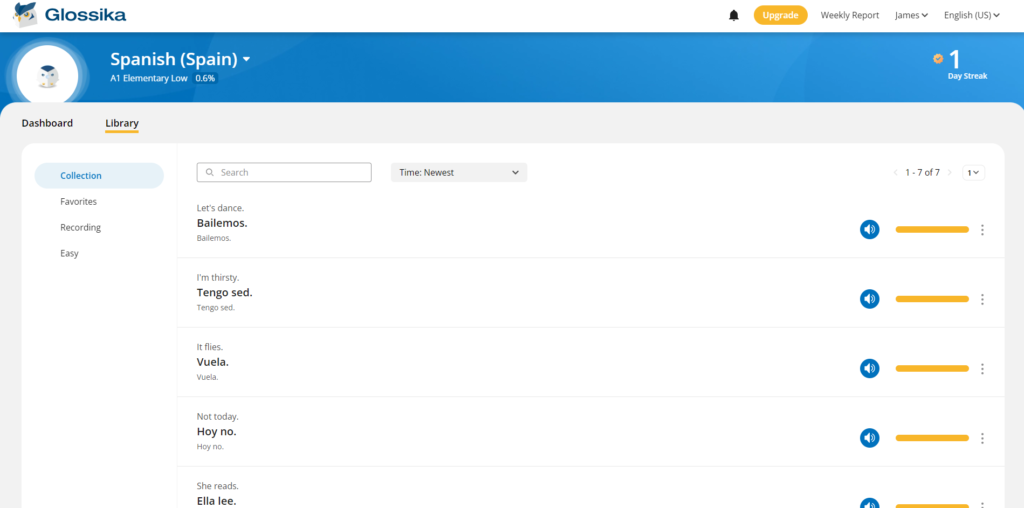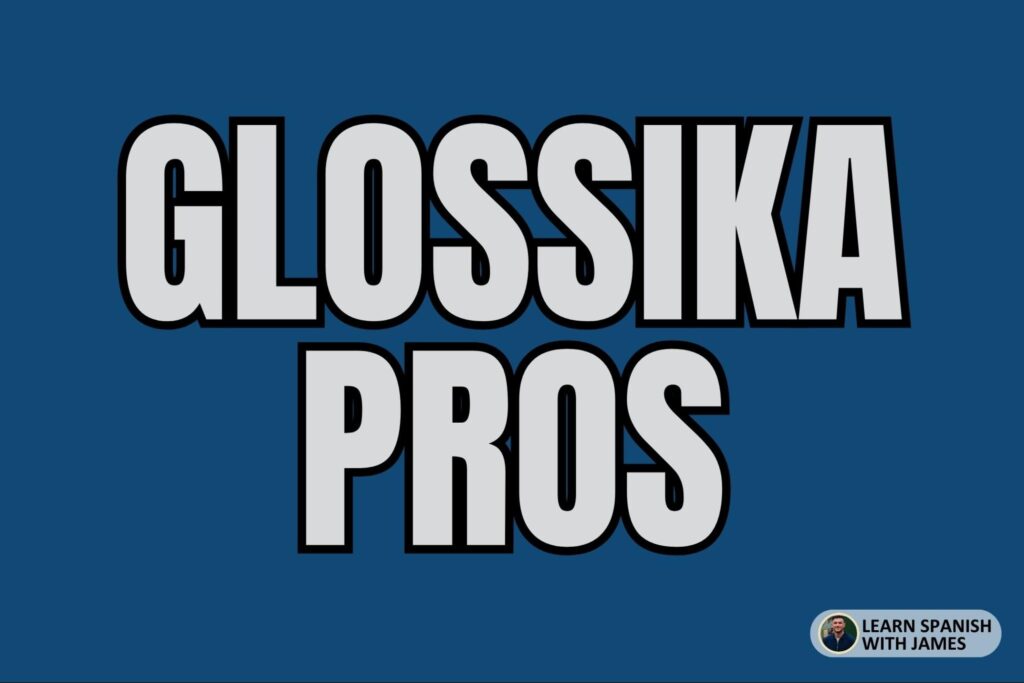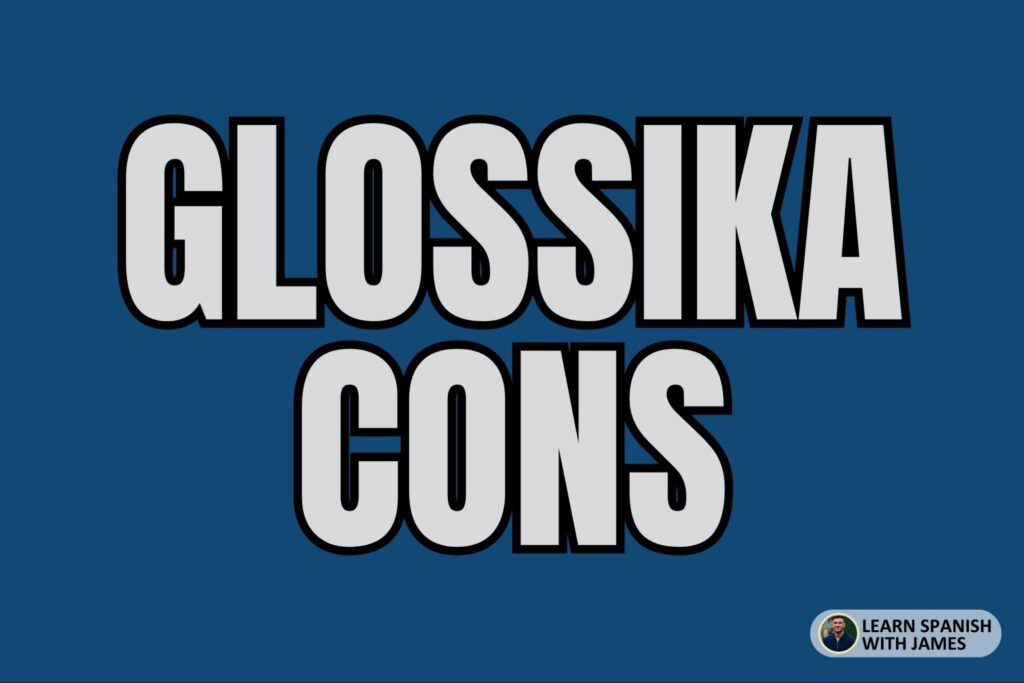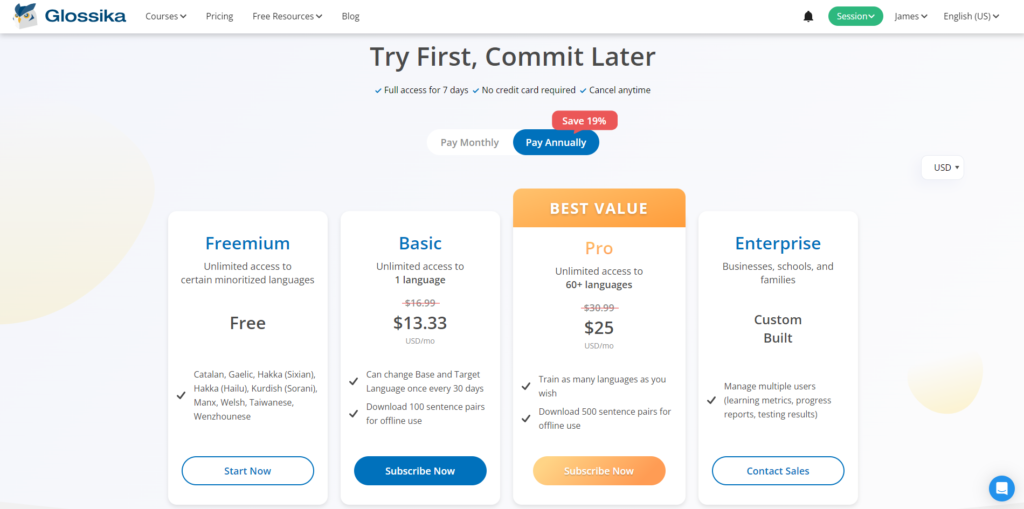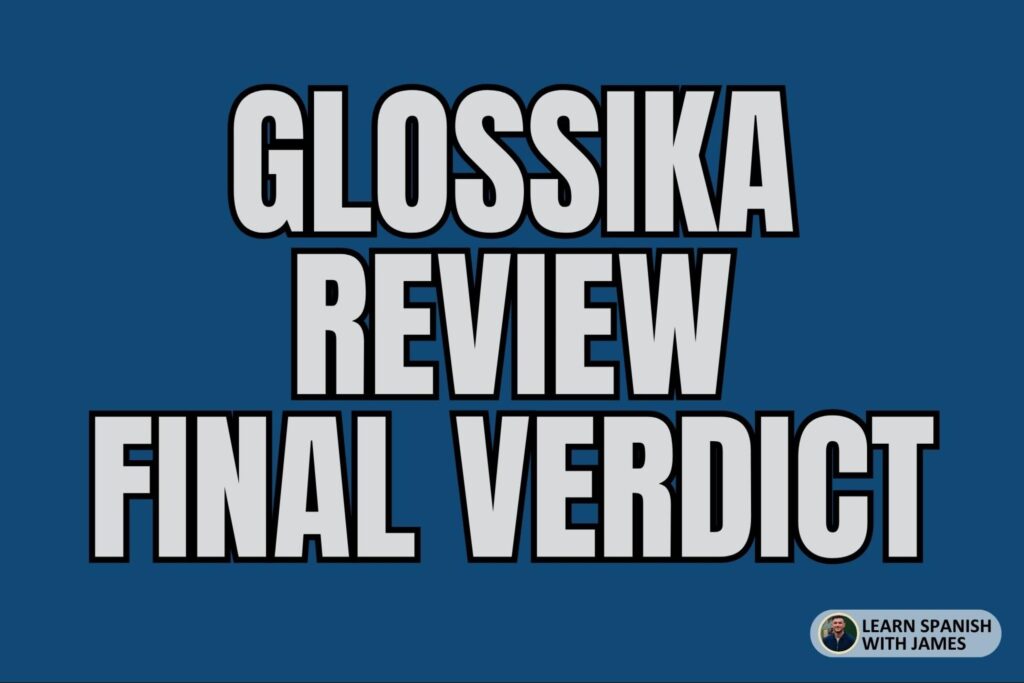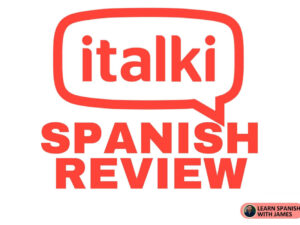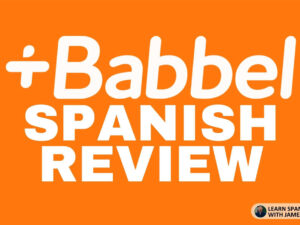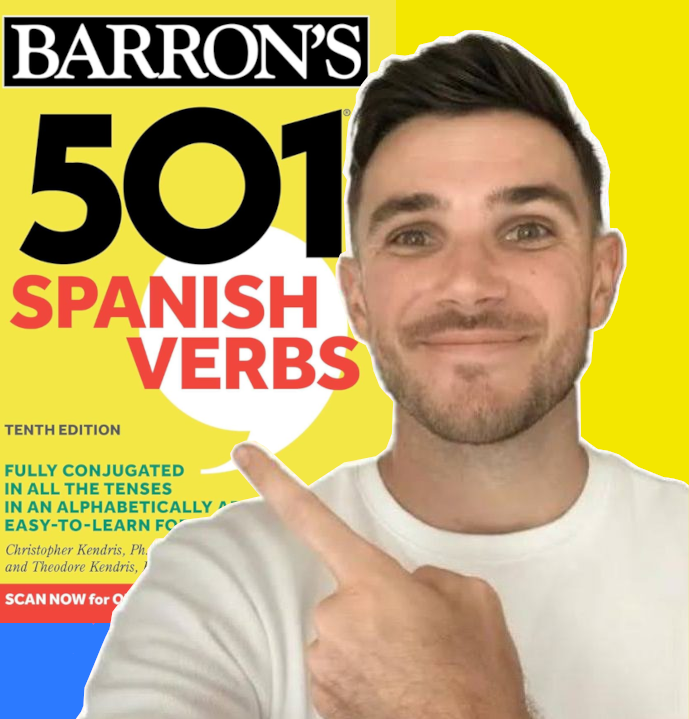Glossika Review: A Focus on Glossika Spanish
- Description
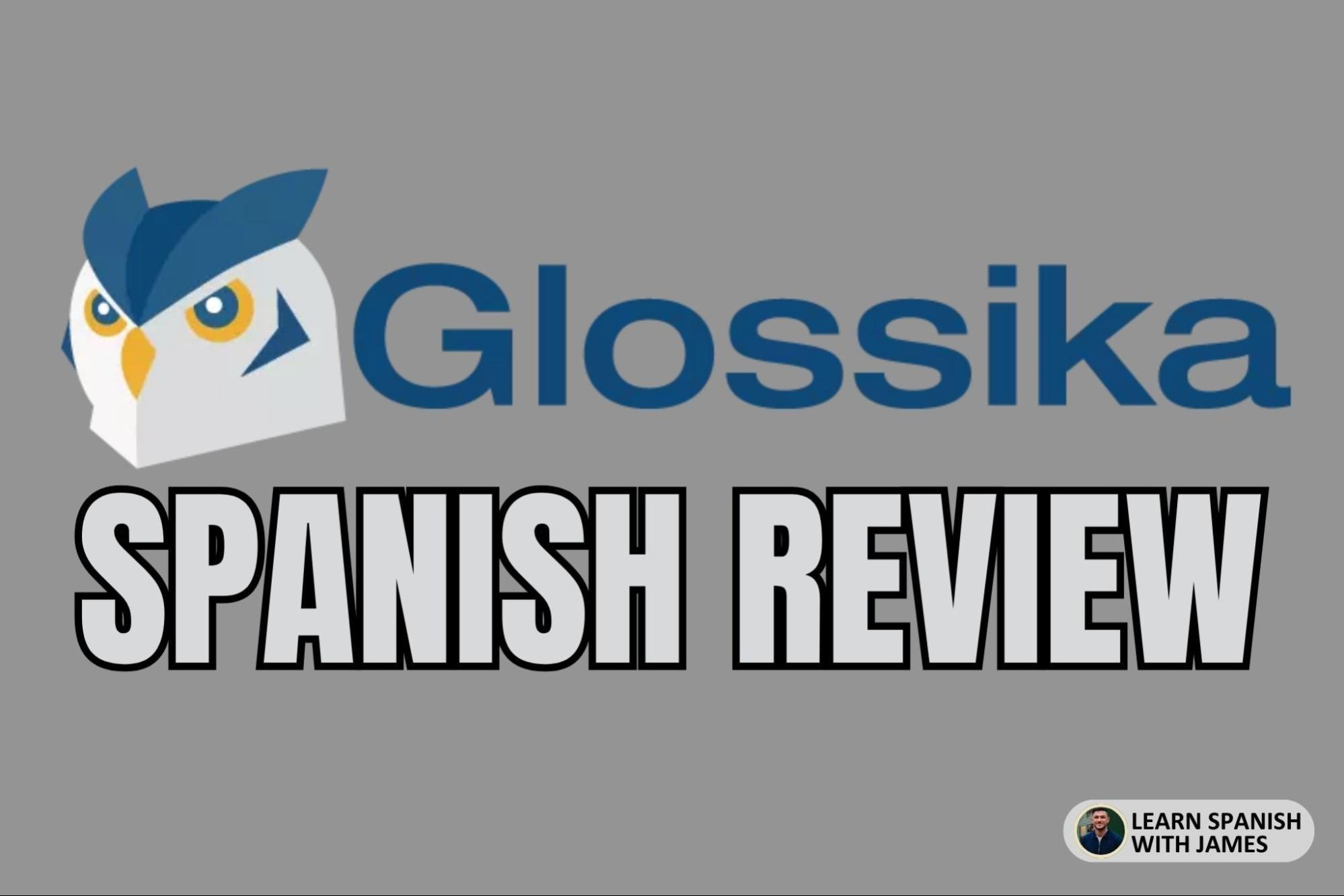
I’m James, from Learn Spanish With James, and in this Glossika review, I’ll take you through Glossika’s effectiveness, strengths, weaknesses, and what I believe to be its suitability for Spanish learners.
While learning new language content may initially seem straightforward, the true challenge lies in the grind of practicing and internalizing thousands of words and phrases.
I believe that this less glamorous aspect of language acquisition is where the Glossika method shines, despite facing criticism for its repetitive drilling method.
Key Takeaways
👉 Glossika does not boast a unique methodology, but it does provide spaced repetition in a digestible, effective way
👉 Pricing is competitive and affordable for beginners
👉 Multiple languages are available, and the methodology is the same for all
👉 The investment into Glossika means its UX (user experience) and interface are very high quality
About Me & How I Wrote This Glossika Review
I’m James, a teacher of English, Spanish, and French. I am also the founder of the Learn Spanish With James blog, and the Learn Spanish With James podcast.
This Glossika review presents an impartial evaluation of Glossika, a popular language learning platform.
In order to write it, I focused on:
👉 Its effectiveness
👉 Its cost efficiency
👉 User-friendliness for newbie language learners
This review also compares Glossika with other language learning apps, Spanish courses and resources in terms of effectiveness and affordability.
The viewpoints expressed in this assessment are unbiased and grounded in personal experiences, but I am looking at the UX and dashboard from the viewpoint of someone who already speaks Spanish.
So, please take this into account 🙂
Throughout the review, I cover:
Effectiveness
This refers to the progress you can expect to make when using Glossika.
Value for Money
I analyze and evaluate the cost-effectiveness of Glossika in contrast to other available language apps and courses.
Ease of Use
When I talk about ease of use, I refer to the user experience, a factor I know to significantly impact learner engagement and progress.
A smooth and intuitive user interface often correlates with enhanced progress, whereas a cumbersome user experience may impede learning advancement.
The Glossika Method – Make Sure You Read This!
The Glossika method revolves around spaced repetition and memorization, focusing on the assimilation of thousands of sentences in the target language.
Unlike traditional flashcard apps, Glossika emphasizes the recall of full sentences, incorporating a strategic range of grammar structures to aid learners in internalizing language rules.
Sound complex? It’s not. In clearer terms, Glossika helps you to memorize full sentences by using them over and over again.
The aim is that, in time, you become able to ‘manipulate’ the language you’re learning, and use it in a range of different contexts.
Spaced Repetition System (SRS)
At the core of Glossika’s approach lies the spaced repetition system (SRS), akin to a GPS guiding you towards a level of linguistic fluency.
As a learner, you’ll engage with five new sentences at a time, followed by five repetitions of each sentence.
The system intelligently adjusts learning speed and sentence order for maximum efficiency.
Review Stage
The review stage is where Glossika truly shines.
As a learner, you are encouraged to allocate as much time to reviewing previously learned content as you are to learning new material.
I like this method a lot.
As a teacher, I agree that studying and reviewing what you have learned in a lesson is just as important as the lesson itself.
And within the Glossika platform, a built-in memory bar notifies users when sentences begin to fade from memory, prompting timely reviews to reinforce your learning.
Exploring Glossika’s Features
In this stage of the Glossika review, I will take you through Glossika’s features.
These are designed to enhance the learning experience, catering to diverse preferences and learning styles.
Native Speaker Recordings
Glossika enriches the learning experience with authentic native speaker recordings.
These audio resources enable users to master pronunciation, intonation, and accent in the target language.
By listening to and echoing sentences recorded by a native speaker, you enhance your ability to sound more natural.
Personalized Content and AI Technology
The Glossika platform uses AI technology to tailor learning speed and sentence selection, ensuring an optimized learning experience for each user.
Listening Only Mode and Progress Tracking
This feature is great for on-the-go learning; Glossika offers a convenient ‘listening only’ mode.
Additionally, users can set daily goals, track their progress, and receive weekly reports to monitor their learning journey.
Mobile and Desktop Accessibility
Glossika also offers accessibility via both mobile apps and web-based platforms.
This versatility allows you to engage in lessons on-the-go or partake in structured learning sessions from your desktop.
The Course Contents
The short phrases taught through Glossika are pragmatic and rich in everyday vocabulary, facilitated by a repetitive learning approach, which aids in cementing them as acquired vocabulary.
I believe that Glossika’s spaced repetition method effectively enhances fluency and speaking proficiency. It’s a method that was proven in the past by linguist Paul Pimsleur (the founder of Pimsleur).
The purpose of this method is that you are able to readily communicate with native speakers and express yourself proficiently in a relatively short span.
As you progress through the lessons, the complexity of sentences gradually increases.
Furthermore, the listen-and-repeat exercises serve as highly efficient tools for transferring phrases from short-term memory to long-term memory, fostering retention and recall.
The Glossika Milestones
Glossika asserts that through the completion of thousands of sentence repetitions, learners can attain various milestones:
- 25,000 Reps: Comfortably speaking sentences
- 50,000 Reps: Initiating casual conversations at natural speeds
- 75,000 Reps: Advancing proficiency in more specialized topics
- 100,000 Reps: Attaining mastery, enabling fluency in diverse conversational contexts
Based on this, it’s not too hard to anticipate or measure your progress.
A beginner who dedicates themselves to 75 sentence repetitions per day over the course of a year can anticipate becoming adept at speaking sentences comfortably and progressing towards engaging in casual conversations at a natural speed.
Getting Started
Getting started with Glossika is easy.
Upon registration, you’ll have the opportunity to select your desired language from their extensive list of over 60 options, which includes rare languages like Georgian, Uzbek, and Mongolian.
Cool, right? I don’t know where else I’d find the resources to learn Uzbek!
Additionally, you can choose from a wide range of source languages.
This makes Glossika an ideal tool for “laddering,” such as having a source language like French to learn Spanish or a source language like Russian to learn Chinese.
After selecting your language, you’ll undergo a brief comprehension test to determine your proficiency level on the standard CERF framework.
While the test is straightforward, consisting of fewer than 10 listening comprehension questions, you can always adjust your starting level if needed.
Progress With Glossika
In addition, Glossika claims to accommodate learners from absolute beginners to advanced speakers, although it’s advisable to have some basic knowledge of your target language before diving in.
The program teaches only new sentences, so an ideal student would typically be at least at the B1 (intermediate) level, possessing a foundational understanding of the language.
From your dashboard, you can start with two training modes: the intensive “full-practice” mode or the “listening-only” mode, with the option to toggle the speaking component on or off.
Each Glossika lesson comprises various activities, including typing to reinforce what you read and hear, dictation to enhance listening comprehension, listening to audio clips, and recording yourself to practice speaking.
Glossika recommends adhering to their “Glossika 4” daily schedule, which comprises four short sessions dedicated to either reviewing previously learned material or acquiring new sentences, facilitating a structured and consistent approach to learning.
Personalizing Your Experience
You have the option to establish a daily repetition target, which significantly impacts session duration.
A recommended initial goal is 25 repetitions. As you become more familiar with the process, you can raise your daily target.
To optimize efficiency and avoid spending unnecessary time on simple sentences, you can use the “mark easy” feature.
This enables you to skip sentences that you find too easy.
I believe the customization aspect is crucial as it tailors your Glossika experience to your specific learning targets in different languages.
Additionally, you can modify the trainer’s functionality by adjusting its settings according to your needs.
How Good Is Glossika Spanish?
Let’s now examine whether Glossika is particularly effective for Spanish language learners.
Sentence banks may seem straightforward at first glance. The claim is simple: just “listen and repeat.”
However, it’s only after delving into a language for some time that you can actually grasp the nuances of its suitability for a specific language and how to optimize its benefits.
So, this analysis will be broken down into assessing how effectively Glossika addresses the fundamental elements of language acquisition: pronunciation, grammar, vocabulary, and listening comprehension.
Pronunciation Practice
Pronunciation is an area where Glossika excels, as there’s no substitute for immersing oneself in sounds and then attempting to replicate them.
At the beginning of their Spanish learning journey decades ago, many learners have probably dedicated considerable time to language tapes, meticulously repeating every sentence and committing important ones to memory.
I would say that Glossika Spanish improves upon this method in several ways.
Firstly, the sentences are standalone, eliminating the need to learn entire dialogues, some of which may contain irrelevant content.
Additionally, Glossika offers two primary accents for Spanish learners to choose from:
- Spanish (European)
- Mexican Spanish, (which effectively caters to the majority of Spanish speakers).
To maximize the effectiveness of pronunciation practice with Glossika, it’s crucial to actually vocalize the sentences.
While it may be tempting to merely listen and think “I’ve got this,” true understanding of pronunciation nuances only comes through vocalization, or even better, recording oneself.
Fun Fact: Half of the Spanish podcast episodes I record are just forms of Spanish speaking practice, even for me!
Regional Variations
When it comes to regional variations between European and Latin American Spanish, Glossika accurately represents these distinctions.
Both accents are faithfully reproduced, with clear enunciation and high-quality recordings.
It’s worth noting that the translations for European and Mexican Spanish versions appear to have been done independently, resulting in variations even when not strictly necessary.
For instance, the sentence “¡Esto es ridículo!” (European version) is translated as “¡Esto es absurdo!” in the Mexican Spanish version.
While either translation would suffice in both regions, this independent approach ensures that each sentence receives careful consideration from a native speaker perspective, and I like this aspect a lot.
Furthermore, the preference for the “ustedes” plural form in informal sentences is correctly observed in the Mexican Spanish version, adding authenticity to the learning experience.
However, in the second-person singular, either “tú” or “usted” may be randomly chosen without a discernible pattern in both European and Mexican Spanish versions.
Grammar
Personally, I believe that mastering grammar patterns with Glossika presents a considerable challenge.
In fact, for the majority of adult learners, Glossika alone may not suffice, necessitating separate grammar study.
Hence, this Glossika review states throughout that Glossika should not be relied upon as the only learning tool.
According to Glossika’s philosophy and marketing, grammar takes a backseat to learning complete phrases.
While there is truth to this principle – as fluent speakers often do not consciously think about grammar when conversing – it’s crucial to acknowledge the role of grammar as a foundational framework.
In Spanish, grammar provides a scaffold for navigating complex phrases and instills confidence in the accuracy of your speech.
Also, explaining grammar concepts, such as verb conjugations like “quiero, quieres, quiere, queremos, queréis, quieren,” from the verb “querer“, is typically straightforward for learners if taught in the right way.
Given the importance I place on grammar, I would advise against relying on Glossika for absolute beginner Spanish learners.
The reason for this is that I think it’s preferable to have a basic grasp of sentence structure, verb conjugation, and adjective agreement before delving into Glossika.
So, use a textbook to learn the foundational rules of grammar, including sentence structure, Spanish verb conjugation, and noun/adjective agreement.
Then use Glossika as a vast repository of example sentences to reinforce these grammar concepts.
Vocabulary
Learning vocabulary with Glossika Spanish is another noteworthy aspect to address in this Glossika review.
While rote memorization of word lists is beneficial in certain contexts – such as learning fruits, vegetables, animals, and colors – verbs and adjectives demand a more contextual approach.
Glossika excels in this regard by providing sentences that contextualize vocabulary usage.
For instance, while “moneda” typically translates to “coin,” learning the sentence “The dollar is the currency of many countries” demonstrates that “moneda” is also used for “currency” in Spanish.
By learning words within sentences and idioms, you start to create mental associations that enhance retention.
And associating vocabulary with images, memories, sounds, people, and situations facilitates deeper learning.
So, use Glossika to learn how to use verbs, adjectives, and everyday nouns in real-life contexts.
You should also supplement Glossika with other resources to fill vocabulary gaps and engage in rote memorization of essential words.
Listening Comprehension
Glossika serves as an effective tool for enhancing listening comprehension skills, yet it is not a complete solution on its own.
One aspect that Glossika doesn’t fully address is the ability to grasp the overarching idea of a lengthy passage.
Unlike real-life scenarios where listeners must absorb the general gist of a conversation or speech, Glossika presents sentences in isolation.
This format allows you to focus on individual phrases, akin to a circuit training session at the gym, where participants perform quick sets of exercises before moving on.
However, real-life listening experiences demand continuous engagement without breaks to pause and think.
While Glossika provides valuable foundational listening comprehension practice, it cannot replace immersive experiences with extended conversations or audio sources like radio broadcasts or Spanish podcasts.
The Pros of Glossika
Glossika’s strengths lie in its inclusive:
- Subscription model (no high up front payment fee is required)
- Emphasis on speaking skills
- User-friendly interface
- Intuitive bilingual sentences
- Natural pace and intonation
Subscription Model
Unlike other language programs that charge per language, Glossika offers access to over sixty languages under a single subscription.
This inclusivity extends to less commonly taught languages, supporting language preservation efforts.
Allows Learners to Practice Speaking
Glossika stands out for its emphasis on speaking practice, with learners repeating each sentence while recording their own voice.
This active engagement enhances pronunciation and confidence in speaking.
User-Friendly Interface
Glossika’s straightforward platform makes language learning accessible and engaging, with clear instructions guiding users through each repetition session.
Intuitive Bilingual Sentences
The bilingual sentences facilitate vocabulary and grammar absorption with minimal effort, aiding learners in grasping language patterns effectively.
Natural Pace and Intonation
Despite the rapid pace of delivery, I believe Glossika’s recordings maintain the natural cadence of the Spanish language, enhancing listening comprehension for learners.
The Cons of Glossika
While Glossika offers valuable language learning resources, it also has areas for improvement, including:
- Standardized translations
- Seemingly random sentences
- A lack of formal explanations.
Standardized Translations
Glossika’s reliance on generic root sentences across languages can result in a loss of cultural nuance and language specificity, hindering the authenticity of learning experiences.
Seemingly Random Sentences
The selection of sentences prioritizes grammar and sentence structure diversity over practical usage, leading to the acquisition of less relevant or useful phrases.
Lack of Formal Explanations
Despite claiming to promote intuitive grammar learning, I believe Glossika may benefit from incorporating formal explanations of grammar rules to support learners in understanding language patterns more effectively.
Pricing Structure
Glossika offers a range of subscription plans tailored to cater to diverse language learning needs and preferences.
From a free trial to premium plans, each option provides varying levels of access and features.
Let’s delve into the pricing structure to understand the value proposition of each plan.
1. Free Trial
- Duration: 7 days
- Requirements: No credit card needed; Cancel anytime
- Features: Limited access to certain minoritized languages including Catalan, Gaelic, Kurdish (Sorani), Welsh, and more.
2. Freemium Plan
- Cost: Free
- Features: Unlimited access to selected minoritized languages such as Hakka (Sixian), Hakka (Hailu), Manx, Taiwanese, Wenzhounese.
- Note: Ideal for exploring less common languages without financial commitment.
3. Basic Plan (One Language)
- Cost: $16.99 USD per month
- Features: Unlimited access to one language; Change base and target language once every 30 days; Download 100 sentence pairs for offline use.
- Suitable for: Individuals focusing on mastering one language with flexibility in language selection.
4. Pro Plan (Best Value)
- Cost: $30.99 USD per month
- Features: Unlimited access to all the languages in the library (60+ languages); Train multiple languages simultaneously; Download 500 sentence pairs for offline use.
- Ideal for: Polyglots and ambitious learners seeking comprehensive access to a wide array of languages.
5. Enterprise Plan
- Cost: Custom Built
- Features: Tailored for businesses, schools, and families; Manage multiple users with learning metrics, progress reports, and testing results.
- Suited for: Organizations seeking a scalable language learning solution with personalized support and analytics.
Additional Benefits
- Personalized Content: Tailored learning content based on individual interests and proficiency level.
- Review with Spaced Repetition Algorithm: Enhanced learning retention through intelligent review scheduling.
- Hands-free Listening-only Mode: Convenient learning on-the-go without the need for active engagement.
- Weekly Progress Report: Track and monitor learning progress over time.
Glossika Premium Subscription for Students
- Discount: 55% off regular price
- Cost: Starting from $7.65 USD per month
- Eligibility: Verification of student status required
- Benefits: Affordable access to Glossika’s premium features
The Free Glossika Languages
Glossika offers access to specific minoritized languages for training without the need for a subscription*, currently encompassing:
- Catalan
- Manx (UK)
- Welsh (UK)
- Kurdish (Iraq)
- Taiwanese Hokkien (Taiwan)
- Hakka (Taiwan)
- Wenzhounese (China)
- Gaelic (Scotland).
Keep in mind though that although the course content is entirely complimentary, some premium features are accessible solely with a subscription.
The Final Verdict
The listen-and-repeat Glossika method, despite its repetitive nature, emerges as a highly effective tool for language acquisition.
While the absence of comprehensive grammar explanations may lead to occasional frustration, the emphasis on speaking yields rapid improvements in fluency.
When considering value for money, Glossika’s pricing may seem steep, particularly given its limited focus on reading and writing practice and the lack of detailed grammar explanations.
However, for learners prioritizing oral proficiency, the investment could yield significant results.
Both the Glossika website and app offer a user-friendly interface, ensuring accessibility for learners of all levels.
Nevertheless, the app’s repetitive nature may prove tiresome for advanced learners, who may benefit more from supplementing Glossika with resources focusing on listening, reading, and writing skills.
Ultimately, Glossika effectively addresses language learning obstacles for beginners and intermediate learners but may not be the optimal choice for those at more advanced proficiency levels.
FAQs
Here are also some of the most frequently asked questions relating to the various features, pros and cons mentioned in this Glossika review
Is Glossika good for beginners?
Glossika mostly works for beginners if their target language is (at least) somewhat close to their native language. It offers structured learning through sentence-based repetition, aiding beginners in building foundational skills in pronunciation, vocabulary, and fluency.
Can I get fluent with Glossika?
While Glossika can significantly improve fluency and pronunciation skills, achieving fluency solely through Glossika may be challenging. Fluency depends on various factors, including consistent practice, exposure to native speakers, and immersion in the language.
What is the difference between Anki and Glossika?
Anki and Glossika are both language-focused tools, but they differ in their approach. Anki is a spaced repetition flashcard app where users create and review their own flashcard decks, including vocabulary, grammar, and phrases.
How long does it take to learn a language with Glossika?
The time it takes to learn a language with Glossika varies depending on individual factors such as language proficiency, learning pace, and consistency of practice.
Glossika recommends daily practice sessions and offers structured learning plans, but the duration to achieve fluency skills ultimately depends on the learner’s dedication and effort.
Is there a free version of Glossika?
Glossika offers a freemium model, providing limited access to certain minoritized languages for free. However, full access to Glossika’s features and a wide range of languages requires a subscription.
Do you have to pay for Glossika?
While Glossika offers some minoritized languages for free, full access to its features and extensive language offerings requires a subscription.
Glossika offers various subscription plans (check this Glossika review for details) tailored to different learner needs and budgets.
How long does it take to finish Glossika?
The time it takes to complete Glossika varies depending on factors such as the learner’s pace, frequency of practice, and language proficiency goals. Glossika provides structured learning plans, but the duration to finish the program can range from several months to a year or more.
Does Glossika have an app?
Yes, Glossika offers both a mobile app and a web-based platform. The Glossika app allows users to access Glossika’s features and courses conveniently from their smartphones or tablets, providing flexibility and accessibility for learning on the go.
What are some language learning apps as an alternative to Glossika?
There are several other apps available as alternatives to Glossika, including Duolingo, Rosetta Stone, Babbel, and Memrise. Each app offers unique features and approaches to learning languages, allowing each type of language learner to choose the platform that best suits their preferences and goals.
What is the best way to use Glossika?
The best way to use Glossika is to incorporate it into a well-rounded learning routine. Combine Glossika’s sentence-based repetition with other resources such as textbooks for your target language, immersion experiences, a language course with a tutor, other interactive language learning apps, and interactions with native speakers.
Summing Up: Glossika Review: A Focus on Glossika Spanish
Glossika sorts natural languages based on their structural complexity and level of difficulty, providing enhancement in memory retention of new vocabulary, pronunciation accuracy, and fluency development.
With features like the ability to set daily repetition goals and personalized learning experiences, Glossika offers a versatile platform for learners to tailor their language journey to their individual needs.
The incorporation of native speaker recordings ensures exposure to natural speech patterns, aiding in pronunciation and fluency development.
While Glossika’s main focus lies in sentence-based learning, it effectively supplements other language resources.
Additionally, the availability of a free trial allows prospective users to explore the platform and assess its suitability for their learning goals.



